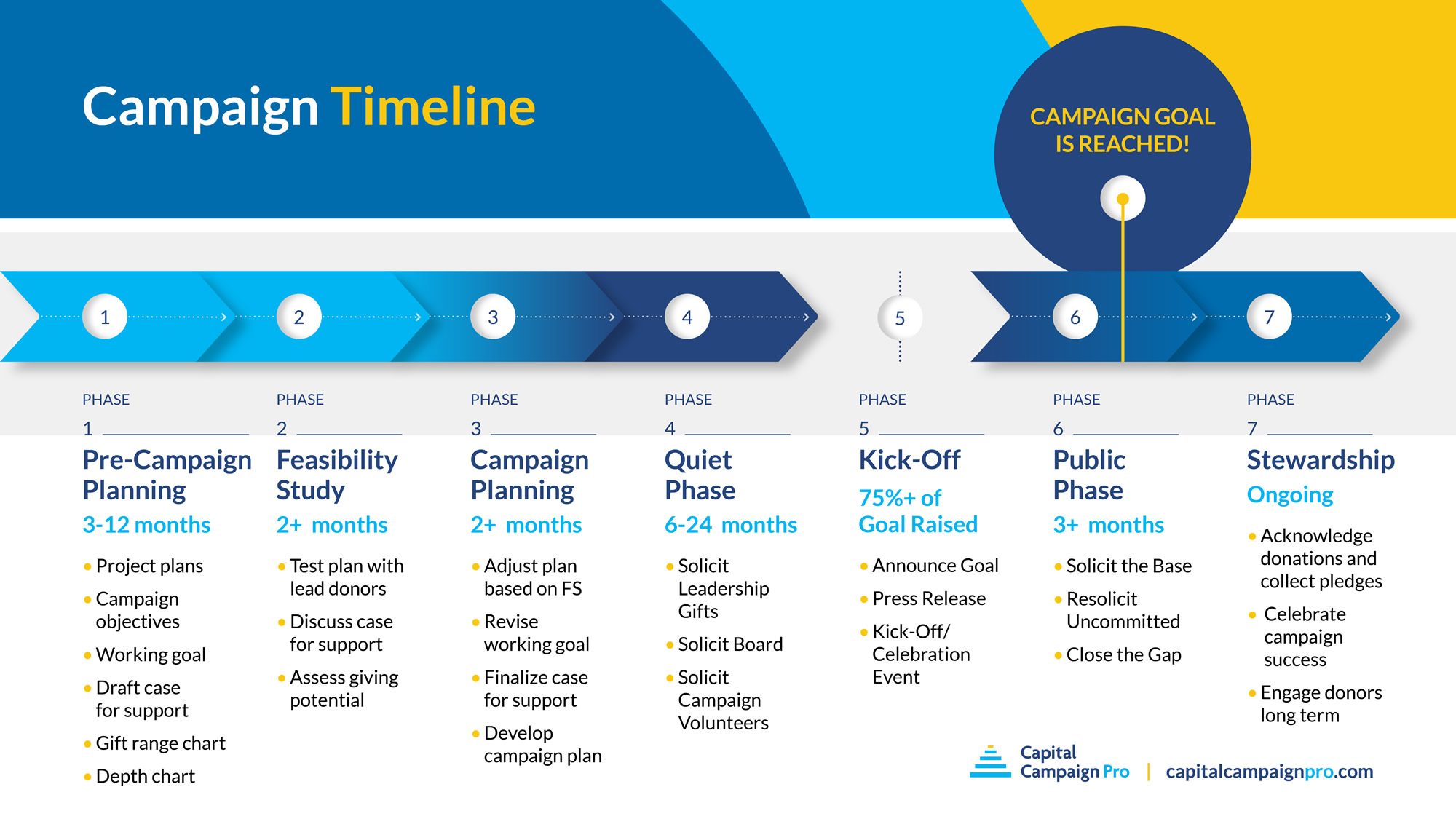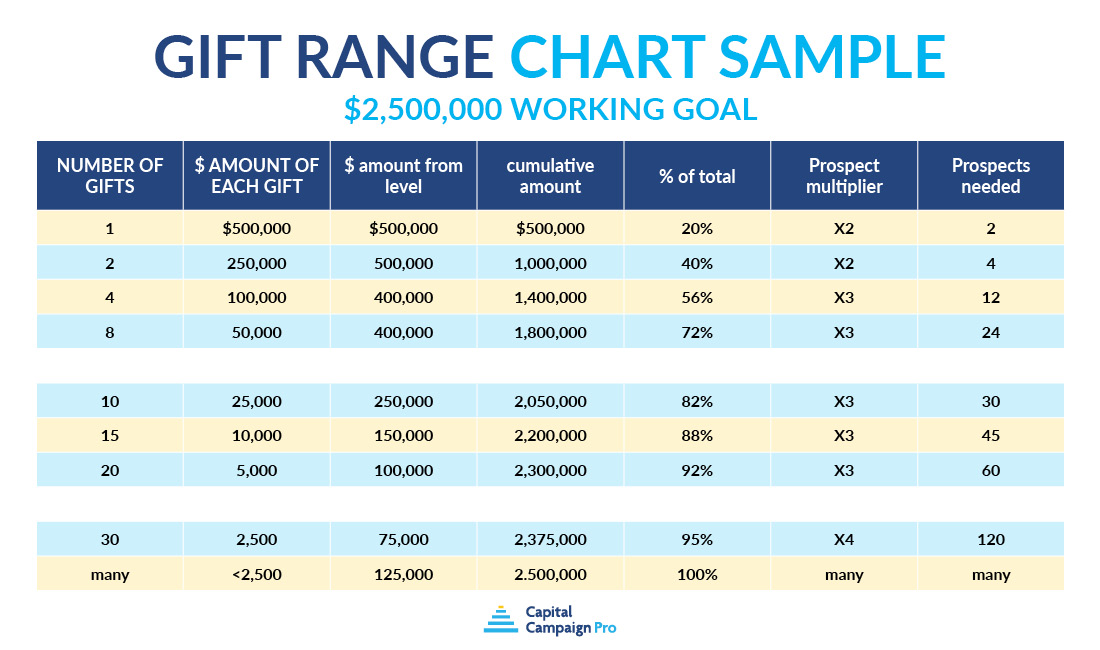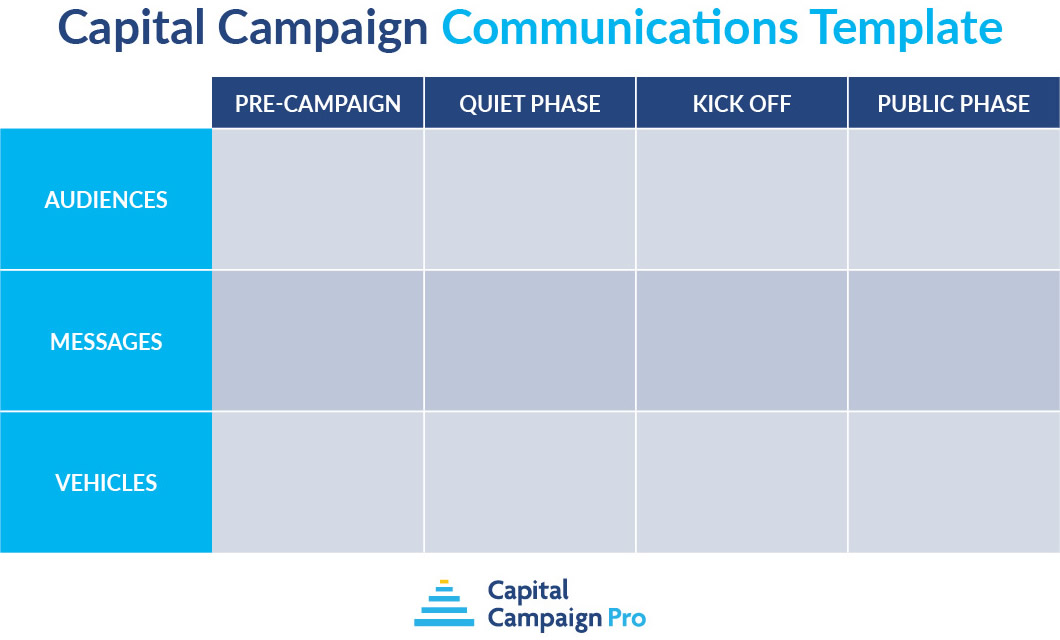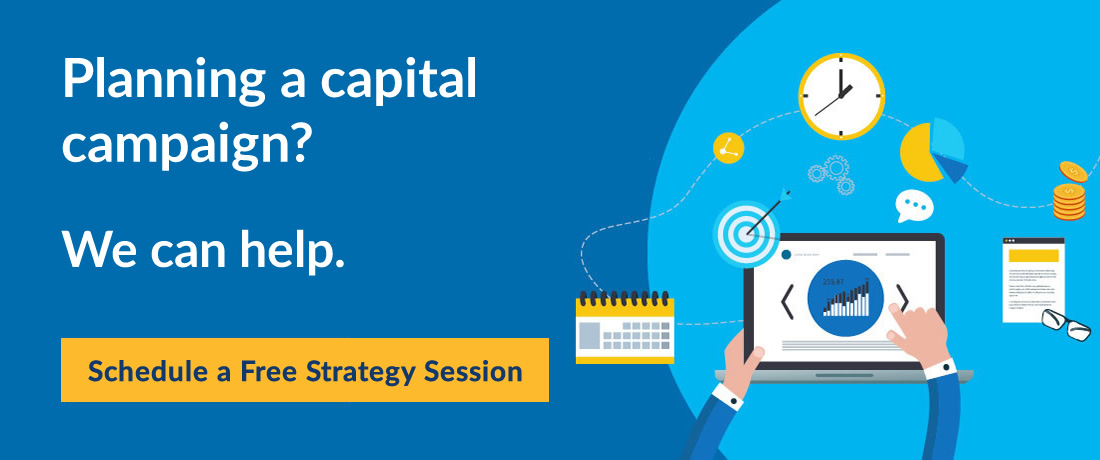Capital Campaign Plan: 11 Essential Elements & Top Tips

If your boss asked you to put together a plan for your organization’s upcoming capital campaign, would you know what to include?
Probably not. Why?
For decades, organizations have relied on campaign consultants to write their capital campaign plans, so they’ve seemed a bit mysterious.
Quick Links — In this post, you’ll get the skinny about developing your campaign plan through the following points:
- What Is a Capital Campaign Plan?
- How To Develop Your Capital Campaign Plan
- Top 3 Tips for Your Capital Campaign Plan
Are you ready to create a winning capital campaign plan to empower your team?
Let’s get started!
What Is a Capital Campaign Plan?
A capital campaign plan is a collection of vital information about your campaign. It’s often organized into one document and spells out how you will conduct your campaign.
A clear, well-written campaign plan serves as an essential reference for all of the decisions you make over the course of your campaign.
With this plan, you’ll feel more confident. Your executive director will breathe a sigh of relief and your board members will be happy. All of your high-level campaign volunteers will entrust you with their efforts, knowing that you’re not flying by the seat of your pants.
Writing your campaign plan may seem daunting, but it really doesn’t have to be that complicated! Whether the format is simple or more elaborate, what truly matters is that it aligns with the style of your organization.
So, whether it’s a beautifully organized, 30-page spiral-bound notebook, a three-ring binder, or a simple word document with navigation — the goal is to create a guide for your campaign that your team will benefit from as you start your campaign.

Capital Campaign Timeline Overview: 7 Key Phases
Before discussing the creation of your capital campaign plan, let’s explore a quick overview of the seven main phases of a capital campaign:
- Pre-Campaign Planning
- Feasibility Study
- Campaign Planning
- Quiet Phase — learn more about this key phase
- Kick-Off
- Public Phase
- Post-Campaign
Explore these phases in further detail in the below graphic:

Your campaign plan is constructed during the first three phases of your campaign — the pre-campaign planning phase, the feasibility study phase, and the campaign planning phase.
As we discuss the 11 essential elements to include in this plan, it’s important to remember that these elements aren’t compiled on day one. It is likely to take many months to develop your campaign plan.
How To Develop Your Capital Campaign Plan
The components of your campaign plan will be created during the early stages of your campaign. You will test many of those elements in a feasibility study.
Once your feasibility study is done and you have a clearer sense of the campaign, you’ll finalize these elements and pull together all of the pieces of the plan.
The act of pulling these various elements together into a single well-formatted document is what brings your campaign into clear focus. So let’s explore a high-level overview of what you’ll do when your Executive Director asks you to develop a campaign plan:
- You’ll make a list of the items that should be in the plan.
- You’ll pull together the elements of your campaign plan that are readily available and start developing those that are still missing.
- You’ll weave these elements together into a simple document with a neat table of contents.
- You’ll create a cover page, titled “DRAFT of [DATE].”
Then you’ll circulate this plan around your team to continue refining it. With that, let’s dive deeper into step one!

11 Elements to Include in Your Capital Campaign Plan
1. Objectives
What are you going to raise money for through your campaign? It likely depends on your core mission, but common answers include new facilities, upgrading technology, or perhaps even building your endowment fund.
It’s important to not only identify your main objective (i.e. “construct a new facility”) but to also identify key specifics surrounding that task. For example, when concerning new facilities:
- What will the building be used for?
- What will the new construction look like?
- What are the benefits of the new construction when it comes to advancing your cause?
It’s important to clearly articulate these details, as your most impactful donors will want these answers.
2. Goals
What are the financial goals of your campaign? Does your campaign have any non-financial goals? While you surely have an overall fundraising amount (the one that’s needed to fulfill your above objective), you may have other non-financial ideas in mind.
For example, you may have the non-financial goal of expanding your donor base or identifying and engaging more major gift prospects. It’s important to articulate these non-financial goals, as well, to ensure they aren’t forgotten in the process.
3. Pattern of Gifts Needed
This is where your gift range chart comes into play.
Your gift range chart should list the gift amounts and number of gifts at each level that you’ll need to reach your goal. Check out the example below:

A depth chart that lists donors according to the amounts on the gift range chart will be an important companion piece to the gift range chart.
On your depth chart, you will include all of the qualified prospects you have for the lead and major gifts of your campaign. These should include foundations, corporations, and individuals.
Identify key prospects, organize them by ask amounts and put them in a simple depth chart. This process will help you identify key prospects and give your team a better chance for success going forward.
4. Donor Recognition
Your campaign plan will include a plan for recognizing donors. Use the levels in the gift range chart to structure the donor recognition plan for your campaign.
How will donors be recognized for their gifts to your campaign?
Some organizations offer naming opportunities — if that’s you, it’s time to outline exactly what those opportunities will be.
For example, you may offer donors contributing your larger gifts the opportunity name specific spaces and rooms in their honor. You may also include their names and the names of donors at lower levels in a group plaque.
However, also consider how you’ll recognize donors across the various giving levels — not just the few at the top and middle levels of your gift range chart. Will you recognize them in written materials, conduct thank-you phone-a-thons, or maybe even host an appreciation event at the culmination of your campaign? Nail down these specifics ahead of time.
5. Structure
Regarding structure, we’re specifically referring to your team. Consider the following:
- What leadership structure will your campaign have? Consider whether you’ll have co-chairs, honorary chairs, and how they will work alongside the existing structure of your nonprofit.
- What are the committees and task forces you expect to use in your campaign? Will you follow a more traditional structure, with an official planning and steering committee? Will you dive deeper into this, and break your committees out by task (ex: major gifts, event planning, etc.)?
In addition to outlining this structure, consider taking things a step further. Consider outlining what role each of these groups play, and when in the campaign they will be active.
6. Staffing
Your capital campaign plan should spell out the responsibilities staff members will have in your campaign.
First, consider which staff members will fill the various roles in your campaign — as are outlined in the “structure” step. Are there certain staff members that are well-suited to step into planning and steering roles? Allocate tasks accordingly.
From there, consider the tasks you might ask staff members to complete. There may be steps of your campaign that can’t be fulfilled by your campaign committees alone — for example, large-scale appreciation efforts. Can you bring in other staff members or volunteers for additional assistance in those times?
Remember that capital campaigns are massive efforts, and they take a strong staffing strategy to be successful. This may mean investing in hiring new staff members to ensure you’re ready for the challenge.
7. Communications
There are two crucial considerations when it comes to campaign communications.
First and foremost, how will your staff communicate across campaign teams?
Create procedures for communicating updates, challenges, and wins across your campaign team to ensure nothing falls through the cracks as the effort continues and inevitably grows more complicated.
Second, what will be your strategies for getting the word out about your campaign?
You’ll most likely want to use a multichannel strategy, including printed and digital materials, spoken conversations, and perhaps even events. It’s important that when you’re using multiple channels and materials for communication, these channels are integrated with one another. This means they build upon one another, rather than creating an overwhelming echo chamber.
Reference the below template for inspiration as you begin outlining your capital campaign communications:

8. Budget
This is a big one: How much will your campaign cost?
Remember that capital campaigns are often years-long affairs. So, first and foremost, be sure to develop the campaign budget for the full duration of your campaign, not only for the first year of operations.
After that, consider your budget in the scope of your overall fundraising goal itself. You should aim to raise a total contribution amount of your fundraising goal plus your campaign budget, to ensure your campaign truly reaches its goal.
And finally, be realistic! If your nonprofit has a more elegant style, be sure to budget accordingly. Don’t skimp on your campaign budget now to make things look better on the front-end. It’s better to be under budget and over-prepared than over budget and unprepared.
9. Timetable
By timetable, we literally mean a calendar in which all key dates for your campaign are outlined. When building this, go phase-by-phase.
Begin with setting general dates for the rollout of each phase of your campaign — for example, when do you anticipate kicking off the public phase of your campaign?
From that point, dive deeper by setting dates for specific efforts within each phase, such as donor stewardship efforts, appreciation efforts, and even benchmarks to measure success along the way.
Finally, set a date for when you anticipate reaching your goal. However, remember that these dates may change — and while you want to stay on track, it’s understandable if this initial timeline shifts along the way.
10. Policies
When you’re collecting a massive amount of gifts (for many nonprofits, capital campaigns represent their largest fundraising efforts), it’s crucial to carve out policies to guide your campaign fundraising.
Your campaign policies should answer key questions about your campaign. Consider the following questions:
- What will be the duration of your campaign?
- What will be the pledge period of your campaign?
- Will your campaign count annual giving toward your overall goal?
- What kinds of gifts will you count toward your goal, and how will you assess their value?
- How will you solicit gifts?
- How will you manage gifts when they’re received?
Aim to answer as many of these questions (and any others that may arise) ahead of time.
Having a clear set of campaign policies you can refer to throughout your campaign will establish an important and consistent basis for making decisions about your campaign. This will instill confidence in your team and your donors alike.
11. Case for Support
It’s easy to focus on your case for support as the be-all-end-all document for your capital campaign. While it is an important resource, especially when you really dive into soliciting gifts, it’s also important to avoid making a glossy, yet ineffective, resource.
Begin developing your case for support with this question:
What is the language your campaign will use to describe your campaign and inspire donors to give?
This information will evolve as you continue planning your campaign, and ideally by the time you kick off the public phase of your campaign, the messaging will be clear and effective.
Top 3 Tips for Your Capital Campaign Plan
Here are our best tips for developing a strong and practical capital campaign plan.

1. Realize Your Campaign Plan Will Grow and Change
Like any planning document, your campaign plan is simply a starting place. Some of the pieces will be developed over the course of your campaign and some aspects may change and shift.
You may also add pieces. For example, you may develop a volunteer guide if volunteer involvement becomes a more prominent part of your campaign. And, you may find that your communications plan expands and becomes more fully-formed over time.
Be sure to date your campaign plan as the iterations evolve. As you update various pieces, indicate the changes by showing a version number and date on the plan itself.

2. Solicit Feedback From Key Supporters As Your Plan Evolves
You may feel tempted — as one of the few with a full bird’s-eye view of your campaign — to construct this living document on your own accord, independently from the rest of your team or supporters. Don’t do it!
We recommend taking a collaborative approach. Create an initial draft of your campaign plan, and share it with different portions of your team:
- Your board.
- Your campaign planning committee.
- Key staff members.
In general, when asking stakeholders to provide their thoughts and feedback on an evolving plan manage their expectations by informing them that you’re soliciting feedback from many players, and will synthesize the information as possible.

3. Enlist Capital Campaign Pro
Our final tip falls close to home, and it’s this: Enlist Capital Campaign Pro for assistance when creating your capital campaign plan.
While some may argue for investing in a third-party capital campaign consultant, we believe that when nonprofit professionals are more involved in planning their campaigns the campaign plans are better than those that rely extensively on an outside consultant.
With our Capital Campaign Pro toolkit, you gain access to:
- A seven-phase plan, with each phase containing a step-by-step guide.
- Worksheets, checklists, and templates that ensure all essential aspects of your campaign are accounted for.
- A guided feasibility study that empowers you to conduct your own pre-campaign research.
- Access to a community of nonprofit professionals that are conducting campaigns just like you do, to share advice, wisdom, and resources.
- Expert advising from Capital Campaign Pro’s team to navigate the challenges of your campaign.
If you’re ready to tackle your campaign but could use a bit of assistance getting started and staying on track, Capital Campaign Pro may be the solution for you.
With that in mind, explore the following additional resources as you plan your capital campaign:









As regards my capital plan that already exists because of I’m longtime to search my working system nevertheless it defines itself from the following manner:
_ Fisrt , leading to set my own board of Ditrectors in a good structure made up of modern working tools in order to facilitate our job;
– secondly, lead the Board of Directors to participate in workshop in relate to the present realities in accordance to our financial Aids and so thank to our new policy;
– Recruiting a group of kids like sample to put into practice our new teaching program;
– thirdly, lead the Board of Directors to supervise the ground activities that is to say the building of Kelo English Center that defined in your project.
Once more thanks for your particular attentiion from me and mmy organization.